
by, Lancer
Maybe it's just me, but I've never thought of a sports anime as having the material to ever become particularly memorable. It's probably just a consequence of watching mandarin soccer anime when you're six years old and can't even guess what's going on.. but I've had an avid distaste for sports anime ever since I can remember.
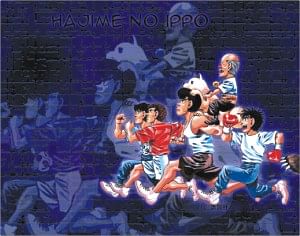 Until, Hajime no Ippo.
Until, Hajime no Ippo.
Sure, it's about boxing, which naturally makes it a hit for anyone with even a drop of testosterone. But the thing is, while Hajime no Ippo has brilliant fights that will, without failure, keep you dangled at the edge of your seats, where it really rocks is between the fights. Every single character (and there's a lot) you ever come across is brilliant, and it is in that gap in the fight cycle between the fights that the characters train, develop, interact, and grow. Each of them, from Ippo himself to the all-conquering indestructible Takamura, have their own reasons for boxing, and one begins to understand their little quirks and eccentricities in terms of them; Ippo, for example, was a wimp who was picked on in school and who took up boxing to build self-confidence. This ability to get on personal terms and relate to the audience is something Hajime no Ippo has in spades, and which sets it head and shoulders above just about anything else.
The fight themselves aren't as black-and-white as the traditional good-vs-evil you see everywhere else; returning to the characters, they're all deep, and the fact that there are a lot of episodes means that just about everyone is explored deeply and given space to flesh out. Takamura's habit of referring to himself as "Ore-sama" (literally: Lord Me) throughout, and the constant nagging-at-(each other's) necks that he shares with the coach sink in very well and give the show an ambient air it couldn't have done without. Likewise, Kimura and Aoki's little side show; the same goes for Ippo's relationship with his mother, who isn't too keen on watching Ippo get beat up in a ring regularly.
Technically, this anime excels too; the character design and style, while being an acquired taste (it gets rather crude as the boxers get their faces beat into pulp) is detailed and vivid, and the animation is fluid, fast, and furious, which fits the fights perfectly. The music complements the series throughout with an unerring knack for the perfect mood, which is saying a lot since the series is paced simultaneously very rapidly and at a slower, take-it-in gait. The show, like Great Teacher Onizuka, has a very strong Japanese flavour in it, which makes it all the more believable; one feels that the director's vision wasn't necessarily something flabbergastingly extraordinary, but rather one of familiarity and understanding the characters.
If there's anything, in any genre, anywhere that would serve as a good parallel, it would be the Rocky series. And I'm sure Stallone would be proud, too. The verdict, if you even need me to tell you by now: Get it.
(while you might not find it in stores owing to its rather large volume, some members on the rsanime yahoo group have the whole series, so that's one place to look.)

By Quazi Zulquarnain Islam
Often a young actress will deliver a performance so strong, so mature she is feted as the Next Big Thing. But the description is usually used more in hope than expectation. We all  know that many years and many films can pass before she'll live up to her early promise, if indeed she ever does. Early 2004, though, saw the arrival of a young talent who seemed near fully-formed, despite being still in her teens. As said, many youngsters break through with one outstanding performance, yet here was Scarlett Johansson, double-nominated at the Golden Globes and BAFTAs for the parts she played in Lost In Translation and Girl With A Pearl Earring. A double-nominee - this showed a consistent level of excellence ordinarily only reached by the likes of Meryl Streep, Julianne Moore and Holly Hunter. And this was an 18-year-old. Surely, there could this time be no doubt that this was the Next Big Thing.
know that many years and many films can pass before she'll live up to her early promise, if indeed she ever does. Early 2004, though, saw the arrival of a young talent who seemed near fully-formed, despite being still in her teens. As said, many youngsters break through with one outstanding performance, yet here was Scarlett Johansson, double-nominated at the Golden Globes and BAFTAs for the parts she played in Lost In Translation and Girl With A Pearl Earring. A double-nominee - this showed a consistent level of excellence ordinarily only reached by the likes of Meryl Streep, Julianne Moore and Holly Hunter. And this was an 18-year-old. Surely, there could this time be no doubt that this was the Next Big Thing.
Actually, close observers had been saying this about Johansson for some considerable time. Way back in 1996 she'd been nominated for an Independent Spirit award for Manny And Lo, then received worldwide plaudits for her part in Robert Redford's The Horse Whisperer. Striking roles in gritty teen flick Ghost World and the Coen brothers' The Man Who Wasn't There pushed her claim still further. Given that kind of CV, her 2004 burst-out seems less sensational than overdue.
She was born on the 22nd of November, 1984, in New York City. Her father, of Danish extraction, was a building contractor in Manhattan, while her mother, Melanie, looked after kids Adrian, Vanessa, Scarlett and Hunter, Hunter being Scarlett's twin, younger than her by three minutes ("the most important three minutes of my life", she's said). As Hunter would grow to 6' 3", with dark eyes and hair, Scarlett would later comment that they were as much like real twins as Arnold Schwarzenegger and Danny DeVito. Scarlett's name was, in a new family tradition, taken from Gone With The Wind, mother Melanie, of course, sharing the name of Scarlett O'Hara's friend and benefactor Melanie Hamilton.
The family having no theatrical background, Scarlett's entry to the industry came almost by accident. A friend of Melanie's, struck by the siblings' good looks, began referring to them as "the cute little Johansson family" and suggested they seek work in commercials. Melanie thought she'd give it a go and took the kids off to an agency for a cold reading. The audition went fairly well, the agents being quite keen on elder brother Adrian, but the other children were deemed surplus to requirements. It was about what Melanie had expected. What she certainly didn't expect, though, was the reaction of her youngest daughter, Scarlett, who went into hysterical fits right there in the office. It wasn't so much that Adrian had been chosen above her, or even that Adrian had been chosen despite not caring if he were chosen or not. It was that, even at the age of 7, she so desperately wanted to make it in TV and films.
After enrolling in classes at the Lee Strasberg Theatre Institute for Young People, she made her stage debut opposite Ethan Hawke in the off-Broadway production of -Sophistry. Her film debut followed in 1994, when she had a supporting role in North, and she subsequently appeared in the little-seen Just Cause (1995) and If Lucy Fell (1996).
Johansson had her first significant screen breakthrough with her role as one of two orphaned teenaged sisters in Manny Lo (1996), a coming-of-age drama directed by Lisa Krueger. Johansson earned an Independent Spirit Award Best Actress nomination for her work in the film, and she soon found herself being tapped by Robert Redford to star as Kristin Scott Thomas' daughter in The Horse Whisperer (1998). Although the film met with a very mixed reception, Johansson was widely praised for her portrayal of a girl who loses her leg and her best friend in a horrific accident.
In 2000, the actress signed on to play one of the heroines (alongside Thora Birch) of Terry Zwigoff's screen adaptation of Ghost World, Daniel Clowes' celebrated comic. That same year, she starred in American Rhapsody.
Though she would take a brief detour into camp with the 2002 giant spider fiasco Eight Legged Freaks, the respect Johansson had gained in the film industry as a result of her previous dramatic roles found the young actress in high demand among indie directors while quickly catching the eye of the Hollywood elite. With Sofia Coppola's Lost in Translation, Johansson's touching performance as a young girl who strikes a tentative friendship with a washed up American actor (memorably portrayed by Bill Murray) while staying in Japan left no doubts regarding her dramatic skills in the eyes of many, and the rising starlet was soon cast in the lead of such subsequent films as The Girl with the Pearl Earring (2003) and The Perfect Score (2004).
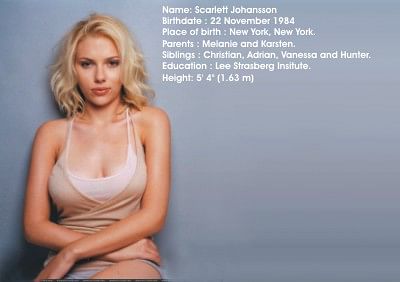 Still more glory was to come immediately when she was also Golden Globe - and BAFTA - nominated for her next picture, Girl With A Pearl Earring, based on Tracy Chevalier's speculative novel. Then would come A Love Song For Bobby Long where she played a headstrong girl of trailer-trash extraction who inherits a New Orleans home from her mother only to find despairing drunken wasters John Travolta and Gabriel Macht living there. Whatever the source of her employment, the buzz around her meant that Scarlett was not wanting for work. She moved on to A Good Woman, an update of Oscar Wilde's first successful comedy
Still more glory was to come immediately when she was also Golden Globe - and BAFTA - nominated for her next picture, Girl With A Pearl Earring, based on Tracy Chevalier's speculative novel. Then would come A Love Song For Bobby Long where she played a headstrong girl of trailer-trash extraction who inherits a New Orleans home from her mother only to find despairing drunken wasters John Travolta and Gabriel Macht living there. Whatever the source of her employment, the buzz around her meant that Scarlett was not wanting for work. She moved on to A Good Woman, an update of Oscar Wilde's first successful comedy
All in all, there can be no doubt that in her maturity, experience and smart role-selection, Scarlett Johansson has made herself into perhaps the finest actress of her generation. Having been bloody mindedly pushing for it since the age of 7, you can't say she doesn't deserve it.
Did you know?
· Is of Polish/Danish descent
· Auditioned for a role in The Parent Trap (1998), which finally went to Lindsay Lohan.
· Had tonsillectomy- the reason for her husky voice.
Personal quote:
· "I have an obsessive character. I manicure my nails at three in the morning because nobody else can do it the right way. Maybe that's the secret to my success."
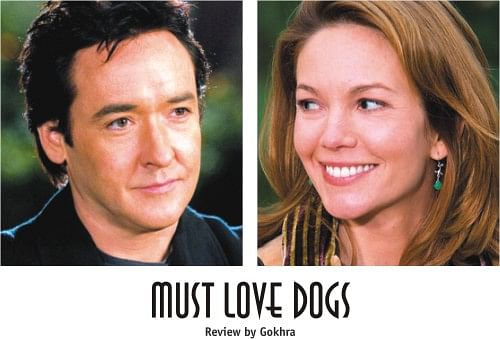
You must love dialogues if you must love the movie Must Love Dogs. It's wordy and so is the movie. But that's a good thing. There's been enough of movies with too much action and style but sparse dialogue all of which can fit on the back of stickum pad. This movie requires you to keep your ears prepped to have fun.
The plot:
It's an eloquently sexy, old-style Hollywood romantic-comedy about Internet dating. The central characters are the dogs because they pretty much make it all happen. But their co-stars who do all the talking are Diane Lane and John Cusack.
Lane plays preschool teacher Sarah Nolan, recently divorced and trying to re-enter the dating game via cyber-flirting. And here's the first small snag of the film. Lane is such a drop-dead gorgeous despite and maybe in spite of her age. So how can a woman like her possibly have any problems meeting or attracting men? Cusack on the other hand plays boat-builder Jake Anderson, a superficially brash but softhearted guy.
Must Love Dogs has some things a lot of today's romantic comedies don't have and need badly: smart dialogue. It's also got bright characters (including the dogs) and a pair of lovers who don't try to act mushy college airheads. They play a thirty-something couple which is close to their real life 40. Yeah, I actually had too much time to check that up.
The story revolves around the life of two people who have been in the love game but also been out of it for a while. They are entering the battlefield again. Sarah is pushed along by her nosy sister, Carol (Elizabeth Perkins), and their rambunctious old dad Bill (Christopher Plummer). Carol of course being nosy as she is signs up her sister without permission for the date site. She writes up a most imaginary bio but then again who doesn't. The bio includes words like "voluptuous" and "sensuous" and a fictitious requirement for "must love dogs." Fictitious because Sarah doesn't have one.
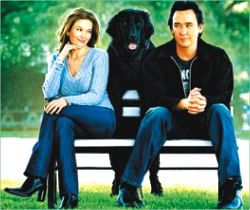 Their father owes his active romantic life with way much younger women to the internet. By the way, he's single so morality issues aren't a concern. The two-facedness and dangers of internet dating is pointed out in a scene where the father turns up as a date for the daughter.
Their father owes his active romantic life with way much younger women to the internet. By the way, he's single so morality issues aren't a concern. The two-facedness and dangers of internet dating is pointed out in a scene where the father turns up as a date for the daughter.
Jake is one of a number of cyber-hunters mostly a sordid collection of weepy, obnoxious or macho creeps. Jake comes up different from the other guys mainly cause he has a dog that doesn't belong to him and an attitude that initially turns Sarah off.
All this is followed by usual formulaic but tastefully conjured complications: cute kids and lots of dogs.
Also in the fray is Dermot Mulroney as smooth Bobby, father of one of Sarah's preschoolers. He is so cool and suave that we know there must be something wrong with him too.
The verdict:
It's a classic Hollywood boy-meets-girl format but it's more original here because they woo each other with words rather than explosive explosions or slapstick comedy.
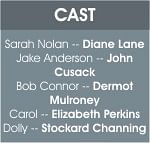 Sarah and Jake zing up their wisecracks with effortless polish and sexiness. Both remind us how much better romantic comedies are when crackling dialogue is as much a part of the game as glamour and sex gags. Also couples don't necessarily have to look like centerfold models although Diane Lane is no doubt hot.
Sarah and Jake zing up their wisecracks with effortless polish and sexiness. Both remind us how much better romantic comedies are when crackling dialogue is as much a part of the game as glamour and sex gags. Also couples don't necessarily have to look like centerfold models although Diane Lane is no doubt hot.
The movie is charming because the script is full of complex and lively love patter. Cusack especially rattles off with sometimes breakneck speed. He's an actor who has nerve-rattling speed and fluency when delivering lines.
Some may think that the movie isn't as funny as most other products of Hollywood. And that happens to be the best thing about it. It's saucy and glamorous. You will love the movie because it is more smart than funny.
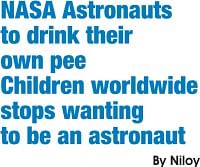 In space, water makes for a heavy - and expensive - payload. Over the past five years, the agency has spent $60 million delivering potable water to the International Space Station on the space shuttle (6 tons at a cost of about Tk 650000 per litre). After starting to recycle the urine, the volume of water hauled into space can be cut by two-thirds and that'll make space for four more astronauts. So NASA is introducing a water purification system that will collect astronaut sweat, moisture from respiration, drain water, and urine - and turn it all into drinking water.
In space, water makes for a heavy - and expensive - payload. Over the past five years, the agency has spent $60 million delivering potable water to the International Space Station on the space shuttle (6 tons at a cost of about Tk 650000 per litre). After starting to recycle the urine, the volume of water hauled into space can be cut by two-thirds and that'll make space for four more astronauts. So NASA is introducing a water purification system that will collect astronaut sweat, moisture from respiration, drain water, and urine - and turn it all into drinking water.
The system can scrub away 99.9 percent of all waterborne viruses, and that could prove particularly useful in the developing world. The United Nations estimates that more than 1 billion people lack access to safe drinking water and that 10 million die each year as a result of contaminated water supplies and inadequate sanitation.
The six-stage system starts with a pre-filter that removes large particles of sediment and debris, such as hair or lint, from contaminated liquid. Next, a carbon filter strips out the organic waste products contained in urine, like urea, uric acid, and creatinine, as well as pesticides and herbicides. The liquid then flushes through a cartridge that contains tiny black beads of iodinated resins. Any micro-organisms collide with the beads, which release iodine to kill the bugs.
The water lingers briefly in a holding tank to give the iodine enough contact time for a complete kill. Next, a resin filter strips out the iodine, along with nitrates and heavy metals. Finally, the water moves through a filter that eliminates cryptosporidium (a waterborne parasite that's resistant to iodine) and provides a final "polish" for good taste. The water tastes pretty good, better than most city taps, and not at all, uh, urinous.
This system can also take some of the dirtiest, nastiest water on the planet and produce clean, safe drinking water. After all, this technology was originally tested on an open sewage ditch in Jakarta and produced water that met Environmental Protection Agency standards.
Human waste has bedevilled NASA engineers from the beginning. Alan Shepherd's first 15-minute suborbital flight was so short that no one thought to install a urine receptacle in his space suit. At T-minus 15 minutes, an electrical problem caused an 86-minute delay on the launch-pad. Shepherd's bladder soon reached the bursting point, and he radioed the first-ever "Houston, we have a problem" message. After some deliberation, mission control had an answer: "Do it in the suit."
Gemini and Apollo astronauts wore plastic bags taped to their buttocks. After defecation, the crew member was required to seal the bag and knead it, mixing in a liquid-bactericide to provide the desired degree of "faeces stabilization." The first men to walk on the moon stepped onto the lunar surface wearing astro-diapers under-shorts layered with absorbent material. That may explain all the jumping up and down.
As a 1975 NASA study put it, "In general, the Apollo waste management system worked satisfactorily from an engineering standpoint. From the point of view of crew acceptance, however, the system must be given poor marks." For the space shuttle, the agency designed a $23 million toilet that freeze-dries solid waste so it can be transported back to Earth. Until recently, the grey water was dumped overboard, becoming an orbiting monument to mankind.
The water filtration system allows NASA to solve two problems at once. It eliminates the grey water disposal issue and recycles urine into drinking water for the astronauts. The agency is testing the system at the Marshall Space Flight Centre in Huntsville, Alabama - where employees run on treadmills as their sweat, respiratory moisture, and urine are collected, cleansed and consumed.
